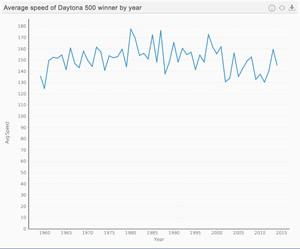Celebrating Star Wars Day 2015 with data visualization
By Eshan Wickrema and Lachlan James
Today is a beautiful day. Why? Because it’s May 4th.
Today is the day that we can dust-off our Darth Vader disguises, jump into our Jedi tunic and cherish our inner Chewbacca as we loudly proclaim in unison: “May the fourth be with you!”. Yes; today is International Star Wars Day.
In recognition of this momentous unofficial event, we thought we’d use Business Intelligence and data visualization to illustrate the enormous popularity of this cultural institution (and epic money making machine). So how much coin has the Star Wars franchise collected at the box office?
The Star Wars saga: First 100 days takings at the box office per film
Insights
How much more milk does the cash cow have to give?
This year, Star Wars loyalists were sent into a Millennium-Falcon-esc-tailspin of almost uncontrollable hysteria with the imminent release of the next instalment in the infamous sci-fi saga, The Force Awakens.
But, let’s be honest. It wasn’t just the super hardcore fans that lost their collective minds when the second official teaser for the hugely anticipated collaboration between Lucasfilm and visionary director JJ Abrams (think the recent Star Trek reboot) signed-off with Han Solo and Chewie proclaiming – “we’re home”!
However, will The Walt Disney Company, who bought Lucasfilm for $4.05 billion in 2012, be able to successfully (financially and culturally) continue arguably Hollywood’s most successful movie franchise without tainting its legacy?
When assessing the box office takings from the six films thus far, it seems that a fine line – between suckling the teat of a very successful cash cow and avoiding alienating a world of fans – will need to be straddled.
The first of George Lucas’ Star Wars films (Episode IV: A New Hope) debuted in 1977, and was followed by two sequels (Episode V: The Empire Strikes Back and Episode VI: Return of the Jedi) in 1980 and 1983.
The original trilogy (Episodes IV, V and VI) made significantly less money within the first 100 days at the box office compared to the contemporary additions to the saga (Episodes I, II, III). Nevertheless, a few important points are immediately evident.
The takings here have not been adjusted to reflect today’s real dollar terms. It’s worth remembering that Star Wars Episode IV, V and VI were the highest grossing film releases in each of their respective years (1977, 1980 and 1983). In addition, each movie within the original Star Wars trilogy made more money at the box office than the last.
By comparison, the first instalment of the second trilogy (Episode I: The Phantom Menace, released in 1999) took $417 million from its first 100 days in cinemas – almost twice that of the most popular movie of the first trilogy (Episode VI), which claimed $227 million. However, the fifth and sixth movies (Episode II: Attack of the Clones (released in 2002) and Episode III: Revenge of the Sith (released in 2005)) performed nowhere near as well as the first of the modern additions (Episode 1), taking $299 and $379 million respectively during their first 100 days at the box office.
These figures reflect the fact that only Episode I: The Phantom Menace topped box office takings for its release year (1999). Episode II: Attack of the Clones (2002) ranked fourth for gross box office takings behind The Lord of the Rings: The Two Towers, Harry Potter and the Chamber of Secrets, and Spider-Man. Episode III: Revenge of the Sith (2005) placed second behind Harry Potter and the Goblet of Fire.
So do these numbers in fact suggest that the early naughties additions to the Star Wars franchise should have actually performed better, given the existing global army of devotees? And, does this then also point toward fan fatigue, or even backlash?
Whatever the case, let’s hope JJ Abrams has done enough to justify the frenzy surrounding The Force Awakens and keep the trust of the Star Wars faithful.
We recommend
Data visualization shows most successful Eurovision nations >

Data visualization reveals success by gender at Eurovision >

Data visualization ’exposes’ nudity in Game of Thrones >

Data Visualization reveals most popular Game of Thrones episode >

Data Visualization: Game of Thrones the most pirated TV show >

Data viz predicts 2015 Cricket World Cup high scoring games >

Data visualization predicts 2015 Australian Grand Prix >

Assessing Daytona 500 championship with Data Visualization >

Today is a beautiful day. Why? Because it’s May 4th.
Today is the day that we can dust-off our Darth Vader disguises, jump into our Jedi tunic and cherish our inner Chewbacca as we loudly proclaim in unison: “May the fourth be with you!”. Yes; today is International Star Wars Day.
In recognition of this momentous unofficial event, we thought we’d use Business Intelligence and data visualization to illustrate the enormous popularity of this cultural institution (and epic money making machine). So how much coin has the Star Wars franchise collected at the box office?
The Star Wars saga: First 100 days takings at the box office per film
Insights
- The original Star Wars trilogy (Episode IV, V and VI) made significantly less money within the first 100 days at the box office compared to the contemporary additions to the saga (Episode I, II, III – takings not adjusted to reflect real dollar terms today)
- Each movie within the original Star Wars trilogy made more money at the box office than the last
- While the first instalment of the second trilogy (Episode I) took $417 million – almost twice that of the most popular movie of the first trilogy (Episode VI), which claimed $227 million – the fifth and sixth movies (Episode II and III) performed nowhere near as well ($299 and $379 million respectively)
How much more milk does the cash cow have to give?
This year, Star Wars loyalists were sent into a Millennium-Falcon-esc-tailspin of almost uncontrollable hysteria with the imminent release of the next instalment in the infamous sci-fi saga, The Force Awakens.
But, let’s be honest. It wasn’t just the super hardcore fans that lost their collective minds when the second official teaser for the hugely anticipated collaboration between Lucasfilm and visionary director JJ Abrams (think the recent Star Trek reboot) signed-off with Han Solo and Chewie proclaiming – “we’re home”!
However, will The Walt Disney Company, who bought Lucasfilm for $4.05 billion in 2012, be able to successfully (financially and culturally) continue arguably Hollywood’s most successful movie franchise without tainting its legacy?
When assessing the box office takings from the six films thus far, it seems that a fine line – between suckling the teat of a very successful cash cow and avoiding alienating a world of fans – will need to be straddled.
The first of George Lucas’ Star Wars films (Episode IV: A New Hope) debuted in 1977, and was followed by two sequels (Episode V: The Empire Strikes Back and Episode VI: Return of the Jedi) in 1980 and 1983.
The original trilogy (Episodes IV, V and VI) made significantly less money within the first 100 days at the box office compared to the contemporary additions to the saga (Episodes I, II, III). Nevertheless, a few important points are immediately evident.
The takings here have not been adjusted to reflect today’s real dollar terms. It’s worth remembering that Star Wars Episode IV, V and VI were the highest grossing film releases in each of their respective years (1977, 1980 and 1983). In addition, each movie within the original Star Wars trilogy made more money at the box office than the last.
By comparison, the first instalment of the second trilogy (Episode I: The Phantom Menace, released in 1999) took $417 million from its first 100 days in cinemas – almost twice that of the most popular movie of the first trilogy (Episode VI), which claimed $227 million. However, the fifth and sixth movies (Episode II: Attack of the Clones (released in 2002) and Episode III: Revenge of the Sith (released in 2005)) performed nowhere near as well as the first of the modern additions (Episode 1), taking $299 and $379 million respectively during their first 100 days at the box office.
These figures reflect the fact that only Episode I: The Phantom Menace topped box office takings for its release year (1999). Episode II: Attack of the Clones (2002) ranked fourth for gross box office takings behind The Lord of the Rings: The Two Towers, Harry Potter and the Chamber of Secrets, and Spider-Man. Episode III: Revenge of the Sith (2005) placed second behind Harry Potter and the Goblet of Fire.
So do these numbers in fact suggest that the early naughties additions to the Star Wars franchise should have actually performed better, given the existing global army of devotees? And, does this then also point toward fan fatigue, or even backlash?
Whatever the case, let’s hope JJ Abrams has done enough to justify the frenzy surrounding The Force Awakens and keep the trust of the Star Wars faithful.
We recommend
Data visualization shows most successful Eurovision nations >

Data visualization reveals success by gender at Eurovision >

Data visualization ’exposes’ nudity in Game of Thrones >
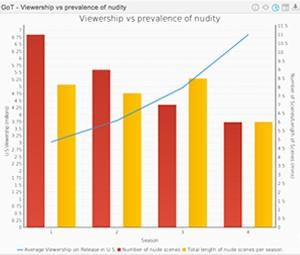
Data Visualization reveals most popular Game of Thrones episode >
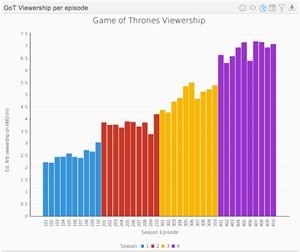
Data Visualization: Game of Thrones the most pirated TV show >
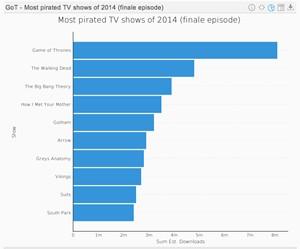
Data viz predicts 2015 Cricket World Cup high scoring games >

Data visualization predicts 2015 Australian Grand Prix >
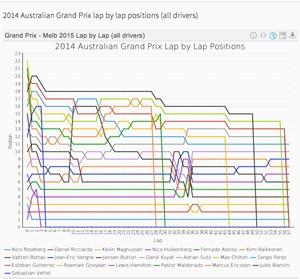
Assessing Daytona 500 championship with Data Visualization >
